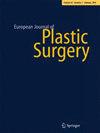A single-center cross-sectional study comparison between quality of life after penile inversion and sigmoid colon vaginoplasty in Thailand: a 20-year experience
IF 0.8
Q4 SURGERY
引用次数: 0
Abstract
Abstract Background Penile skin inversion vaginoplasty (PIV) and sigmoid colon vaginoplasty (SCV) are both regarded as surgical options for gender reassignment surgery (GRS) to improve quality of life (QoL) in male-to-female (MTF) individuals. As no studies have compared the QoL between PIV and SCV techniques, this study aimed to evaluate the differences in QoL among MTF individuals who received PIV and SCV. Methods A cross-sectional study was conducted on patients who underwent GRS using PIV and SCV techniques at King Chulalongkorn Memorial Hospital (KCMH) from January 2002 to December 2022. The calibrated Thai version of Short-Form 36-Question Health Survey version 2 (SF-36v2) was used to assess QoL across eight health domains and to compare QoL between two surgical techniques. Results Of the 278 eligible MTF patients, who received GRS from 2002 to 2022, 57 completed the questionnaires; 37 and 20 MTF patients underwent PIV and SCV, respectively. Statistically significant difference was found in the Mental Component Summary ( p -value = 0.02) of postoperative QoL between the two groups. SCV statistically outperformed PIV in seven out of eight domains. Conclusion In terms of QoL, MTF who underwent SCV showed better achievement than those who underwent PIV in most of the domains. Due to limitations of this study, further studies on a larger scale are needed to confirm the findings and compare other aspects of the surgical techniques. Level of Evidence: Level III, Therapeutic.泰国阴茎内翻和乙状结肠阴道成形术后生活质量的单中心横断面研究比较:20年的经验
背景阴茎皮肤内翻阴道成形术(PIV)和乙状结肠阴道成形术(SCV)都被认为是性别再分配手术(GRS)的手术选择,以改善男变女(MTF)个体的生活质量(QoL)。由于没有研究比较PIV和SCV技术之间的生活质量,本研究旨在评估接受PIV和SCV的MTF个体生活质量的差异。方法对2002年1月至2022年12月在朱拉隆功国王纪念医院(KCMH)采用PIV和SCV技术行GRS的患者进行横断面研究。使用经过校准的泰文简表36题健康调查第2版(SF-36v2)来评估八个健康领域的生活质量,并比较两种手术技术之间的生活质量。结果2002 ~ 2022年接受GRS治疗的278例MTF患者中,57例完成问卷调查;37例和20例MTF患者分别接受PIV和SCV治疗。两组术后生活质量的Mental Component Summary比较,差异有统计学意义(p -value = 0.02)。在统计上,SCV在8个领域中的7个优于PIV。结论在生活质量方面,经SCV治疗的MTF在大多数领域均优于PIV治疗的MTF。由于本研究的局限性,需要进一步进行更大规模的研究来证实研究结果,并对手术技术的其他方面进行比较。证据等级:III级,治疗性。
本文章由计算机程序翻译,如有差异,请以英文原文为准。
求助全文
约1分钟内获得全文
求助全文
来源期刊

European Journal of Plastic Surgery
SURGERY-
CiteScore
1.10
自引率
0.00%
发文量
93
期刊介绍:
Europe has always been an area of dynamic development in plastic surgery. Its great strength has been the lack of uniformity of this development due to differing cultures, different traditions, and differing medical and surgical philosophies. Over the recent years, these changes have been even more striking and rapid. The European Journal of Plastic Surgery creates a focal point for the input of new advances in clinical techniques and in research. It thus becomes an educational vehicle. In addition to this, the journal provides information on what is going on elsewhere in the world, and it is also willing to accept contributions from outside of Europe. Fields of interest include general plastic and reconstructive surgery, head and neck surgery, aesthetic and craniofacial surgery, hand surgery, microsurgery, treatment of bones, trauma, burn management and basic research related to all aspects of plastic surgery.Submitted articles are first evaluated by the Editor in Chief and if judged appropriate, are peer-reviewed by at least two selected experts. Reviewers may be plastic surgeons or other surgical/ medical specialists with expertise in specific areas of research. Manuscripts provisionally accepted for publication may be returned to the author for corrections or clarifications, in response to suggestions by the Editorial Board or external reviewers, prior to final acceptance. Online submission and peer review for rapid online publication are offered through the Editorial Manager System. The system creates a PDF version of the submitted article for peer review, revision and proofing. All correspondence, including the request for revisions and final decision, is managed by e-mail. Authors are guided step by step through the full process and are kept up to date on the article’s progress at every stage. Manuscripts submitted for publication must contain a statement to the effect that all human studies have been reviewed by the appropriate ethics committee and have therefore been performed in accordance with the ethical standards laid down in an appropriate version of the 1964 Declaration of Helsinki. It should also be stated clearly in the text that all persons gave their informed consent prior to their inclusion in the study. Details that might disclose the identity of the subjects under study should be omitted.Reports of animal experiments must state that the ''Principles of laboratory animal care'' (NIH publication No. 86-23, revised in 1985) were followed, as well as specific national laws (e.g. the current version of the German Law on the Protection of Animals) where applicable.Acknowledgments of people, grants, funds, etc. should be placed in a separate section before the reference list. The names of funding organizations should be written in full. Authors are also required to disclose any relationships with public or private commercial or noncommercial entities, any institutional affiliations, or any personal associations that might pose a conflict of interest.The Editors reserve the right to reject manuscripts that do not comply with the above-mentioned requirements. The author will be held responsible for false statements or for failure to fulfill the above-mentioned requirements.
 求助内容:
求助内容: 应助结果提醒方式:
应助结果提醒方式:


